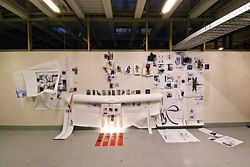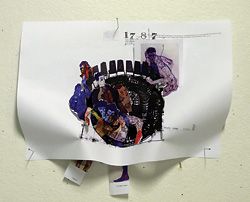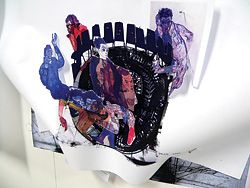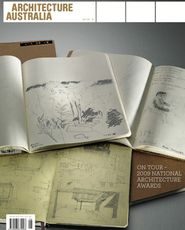


Overview and detail for The Institution for Architecture, by Byron Kinnaird, presented at the Agenda session at RE:HAB. The project was completed in 2007 at Victoria University of Wellington.
Andrew Toland and Philip Clemens respond to this year’s student conference.
This July, for five intense days, architecture students were invited to “check into RE:HAB” at the biennial Australia/New Zealand Architecture Student Congress, hosted by the University of Canberra. As with Institute national conferences, it is a tradition to give student architecture congresses a catchy name. Past titles include The Next Wave, Circus, Flashpoint, States of Mind and CtrlShift. This year’s title was suggestive and more than a little provocative: “rehab”, naturally, implies some kind of underlying addiction. What could architecture students be addicted to, I wondered. Beyond the obvious stimulants of caffeine, nicotine and energy drinks that fuel architecture students before looming submission deadlines, was there a hidden message? Perhaps we are addicted to dominant modes of architectural style? Or maybe current trends in intellectual fashion? Maybe we’re addicted to starchitects? Or to models of practice developed in the boom years? Quite possibly, we’re addicted to our computers; they’re virtually extensions of our bodies when it comes to everything from drawing to socializing to participating in communities.
But the congress didn’t set out to answer any of these questions; the complexities of “rehab” remained tantalizingly unexplored. All too often, the congress seemed to lack a real, coherent organizing principle or set of agendas. The basic assumption of this congress appeared to be that more is better. It proudly proclaimed ninety speakers over the five days. By necessity, there were several parallel sessions, bookended by the main plenary sessions, in order to fit in all the speakers. A more appropriate title might have been Overload. Granted, there were also some workshops and tours interspersed during the days, and parties, drinks and slide nights scattered throughout the evenings, but it was still possible to sit through five solid days of being talked at by architects from nine in the morning to eight at night. This left the impression that, as a profession, what architects are addicted to is the sound of our own voices.
Perhaps at odds with its character and lineage as a student event, this year’s congress had an orthodox, somewhat Establishment feel. Proceedings were officially opened by the consort of our quasi-head of state, “His Excellency” (a title the organizers were careful to emphasize) Michael Bryce. It felt a little like being at the opening of the Olympics. The big drawcard of the first session was Glenn Murcutt, in conversation with the University of Canberra’s new Head of School, Annabelle Pegrum. The conference continued very much in this vein, as the (mostly) elder (mostly) statesmen – Romaldo Giurgola, Richard Johnson, James Birrell, Enrico Taglietti, Sean Godsell – were wheeled out to dispense their wisdom to the assembled masses. At least Louise Cox and Kerstin Thompson were there to represent stateswomen. In fact, this was one of the few areas where the passionate opinions of students were able to flare into view at the congress. Whenever the issue of women in architecture came up it generated an intensity of discussion and exchange between students and practitioners and academics that was notably absent over many other issues. In fact, I suspect there may be an untapped desire for a whole student congress on that one theme alone.
This lack of intensity had more to do with the overall curation and conception of the conference than with a lack of engagement on the part of students. There were relatively few opportunities for students to break into the flow of architectural discourse being presented. The questions after each lecture were lively and intelligent, but these were hardly opportunities for full discussion and debate. The “Agendas” session at least allowed students to hear from fellow students and recent graduates about their visions for the profession and practice of architecture, and the “Group Therapy” session moderated by Timothy Hill did provide a forum for some discussion, albeit one distinctively shaped by Hill’s own psycho-pedagogical agenda. There wasn’t quite the same sense of student energy and empowerment as was on display at the CtrlShift congress in Wellington, New Zealand, two years ago. That congress, while rough around the edges, gave a sense of the wildly creative, diverse and optimistic forces that can emerge when architecture students come together outside the constraints of the academy and the demands of university courses. Nonetheless, the Canberra congress was a logistical marvel; it was obvious just how much work the organizers had put into ensuring that the congress ran smoothly, that we were all fed, watered and bussed around.
The American Psychiatric Association’s Diagnostic and Statistical Manual of Mental Disorders, DSM-IV, lists the diagnostic criteria for addiction: a preoccupation with the drug between times of usage; breaking personal resolutions on how much of the drug to use; repeated failures to cut back or stop using it; being intoxicated at inappropriate times; reducing habitual social, recreational or other activities in favour of using the substance; and continued use despite knowing about the problems it has been or will be causing. Replace “drug” with “architecture” and many of us will wince at the sting of recognition. Far from rehabilitation, student congresses offer a concentrated fix for hard-core student architecture addicts. We might have checked into RE:HAB, but instead of breaking the habit, we’ve come away craving our next hit.
Andrew Toland is a fourth-year student at the University of Technology, Sydney.
There is an architecture fuelled entirely by an idealistic dream of a utopian future, of black and white, right and wrong. A dream of perfection on a foundation of imperfection. It is an architecture of certainty. Certainty in the problem – there must be a problem as there must be a solution.
It is an easy architecture to sell, with the rhetoric of hope and faith, with the promise that we exist in a moment of profound change. A movement of idealism and simplicity, of an architecture that can save the world. Easily purchased, certainty and optimism are rare and valuable commodities. Doubt, fear and guilt are healed through faith in a brighter future, and architecture students buy this vision on impulse. It is an architecture that gives clear direction and perhaps even meaning to our seemingly masochistic tendencies.
RE:HAB spent a large portion of time in the promotion of this architectural reduction. Recitations of “long life, loose fit, low impact” from Tone Wheeler, numerous expositions on “less is more” and even a flashback to first-year history and the Vitruvian tripartite from Michael Bryce. This doctrine searches for problems with available solutions, somehow creating a fictional simplicity in a world of good and bad. Unfortunately, catchphrases and superheroes cannot save the world, and any singular aim is a reduction in the scope, efficacy and potential of the practice and product of architecture.
Yet each of the reductionist presentations is singular. Intellectual rigour is abandoned and replaced with idealistic rhetoric. It is a sales pitch: simple content, basic concepts, small words. The saviour has been found. Wheeler goes so far as to suggest student design projects need to be summarized in three sentences. Clearly a reasonable marketing strategy from his example, but what of the content? Three sentences, a singular concept and idealistic certainty are not enough to produce a relevant architectural proposition.
These presentations encapsulate an architecture for architecture students: reactive, idealistic and certain; this is what we want architecture to be. The reality is, of course, far more complex, the position of architecture far more marginal. The alternative, productive architecture, is presented through image and narrative. Frequently opaque and without clear recipe, it is often difficult to translate and is expressed aesthetically. Enrico Taglietti, for example, discusses the face and the innards of architecture, shows a photo of himself reading the phantom, then stands silently cycling images while Bartók reverberates through the theatre. The projects themselves are far from superficial, they accept and interrogate the shifting ground on which architecture stands.
Anthony Burke of Offshore Studio presents an architecture of exploration rather than colonization. The work is not reactive; it conceives of the world intelligently, exploring the limits of architecture. Perhaps self-consciously self-aware, Burke engages with the reality of uncertainty and the uncertainty of reality. It is this self-awareness that allows engagement in a world undivided by binary oppositions and without illusions of perfection.
Continuing this theme, David Luck examines two houses, one sited on the Mornington Peninsula, the other in an inner-city Melbourne suburb. While the two houses are stylistically disparate they remain coherent through a similar layering of personal meaning – both are the architect’s own homes. These personal explorations express the need for sensitivity to the depth of the physical as well as the non-physical; the houses could not be further from the architecture of one-liners.
And of course there are others. The design process of Terroir as an exploration and revelation of site. Andrew Nimmo and the potential of the graft as a design strategy, exploiting the physical and programmatic complexity of each project. The strategic thinking of Tim Hill or Craig Allchin on the relationship between architecture and the city. Or the oppressive intensity of Sean Godsell, interrogating each project like his last and always pushing for more.
Architecture as belief, strategy or lifestyle, architecture as inspiration. The depth and diversity of projects on show at RE:HAB serve as an expression of just how complex and difficult architecture can be. In a single working week, an equivalent amount of time was spent in lectures as in an entire semester. This active student body is searching for more from architecture and is not, I hope, settling for less.
Philip Clemens is a fourth year student at the University of Technology, Sydney.















